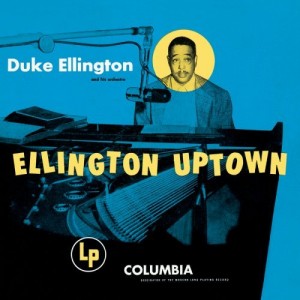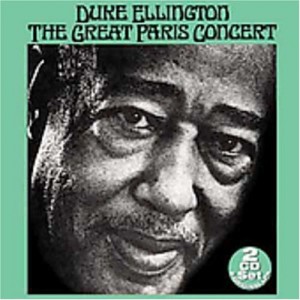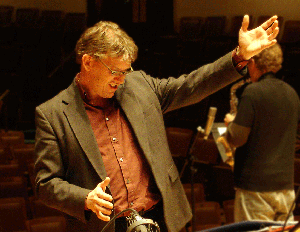Music Review: NEC Jazz Orchestra, directed by Ken Schaphorst — Harlem Comes to Jordan
Why should you have been in Jordan Hall on October 21? First, to hear Ken Schaphorst’s reconstruction of Duke Ellington’s “Harlem,” aka “A Tone Parallel to Harlem,” aka “The Harlem Suite,” a score on which Ken labored painstakingly and which the NEC Jazz Orchestra played thrillingly well.
Music of Duke Ellington. Performed by New England Conservatory Jazz Orchestra. Conducted by Ken Schaphorst. At Jordan Hall, New England Conservatory, October 21, 2010.

NEC’s Ken Schaphorst has been leading the NEC Jazz Orchestra for more than eight years now. Unfortunately, his natural modesty has perhaps kept him in the shadows of illustrious predecessors—Jaki Byard, Jimmy Giuffre, George Russell, and Bob Brookmeyer
By Steve Elman
When I took my seat in Jordan Hall on October 21, I didn’t know I was in for a world premiere.
I came to hear the New England Conservatory’s (NEC’s) Jazz Orchestra perform an all-Ellington program. I didn’t know what the repertoire would be and frankly, I didn’t care. I’ve come to have such trust in the programming of NEC jazz and contemporary improvisation concerts that I know I will usually be pleased, sometimes be delighted, and almost always be satisfied.
It’s an unthinking complacency, I know, fostered by decades of living in a town with a constant influx of stellar young musicians (primarily due to the draws of NEC and Berklee) and a core of gifted, veteran artists who can make their livings here teaching, composing, leading ensembles, and playing (primarily due ditto).
You come to take these things for granted, which is unfair to student musicians and longtime players alike. With nationally-known figures roaring regularly through Scullers and the Regattabar, there often isn’t room on a reviewer’s schedule for a Berklee or Conservatory show. There also isn’t that incentive to get the writing out there as fast as possible in order to scoop another observer. Shame, shame.
Here are two cases in point: the words you’re reading now, about that remarkable concert at the Conservatory more than a week ago, and an upcoming review of the October 25 concert and current CD by the New World Jazz Composers Octet (an ensemble of players associated with Berklee), which will be posted in the next few days.
Exeunt meas culpas.
Why should you have been in Jordan Hall on October 21? First, to hear Ken Schaphorst’s reconstruction of Duke Ellington’s “Harlem,” aka “A Tone Parallel to Harlem,” aka “The Harlem Suite,” a score on which Ken labored painstakingly and which the NEC Jazz Orchestra played thrillingly well.
“Harlem,” as Schaphorst sees it, is a major Ellington work, one that has been unfairly neglected. He told me, “By the time Ellington composed ‘Harlem,’ he had given up to some degree on his attempt at the grand, symphonic work (a la ‘Black, Brown and Beige’), and as a result, ‘Harlem’ seems unambitious by comparison. And there was no grand premiere performance in Carnegie Hall.”
There was, however, a 1950 commission from the NBC Symphony, which should count for something. Toscanini & Company performed it with Ellington’s band at the Metropolitan Opera House in January 1951. (To my knowledge, no recording of that concert has surfaced so far.)
The work was first recorded in a studio in December that year, by the Ellington orchestra alone, and it was released in 1952 on Ellington Uptown, one of Duke’s first Columbia Long Players. It remained in the book for decades, and at least three more live performances of it have been issued, including a very good one from 1963 (The Great Paris Concert, Atlantic UK).
Even though “Harlem” is episodic, like nearly all of Ellington’s extended works, Schaphorst admires its motivic unity, and he points to the first two notes (evoking the title’s two syllables) as the foundation for nearly everything in the 14 minutes that follow. Stanley Dance, apparently drawing on Ellington’s own descriptions, named some of the pictures portrayed in the music: “Here . . . are Spanish Harlem, a parade . . ., a floorshow and chorus line, church, sermon, funeral, a ‘chic chick’ stopping traffic, a Sunday promenade, and [in an anachronistic reinterpretation of music written in 1950] orators making civil rights ‘demandments.’” You can clearly hear the Latin episode, along with a stunningly beautiful section of somber music that probably represents the funeral cortege, but there’s no need for a note-by-note road map to appreciate the teeming energy of Ellington’s valentine to his adopted home.
Schaphorst found an incomplete set of parts for “Harlem” in the Smithsonian’s Duke Ellington Collection archives, and he created the rest of his reconstructed score by listening to the 1951 recording. This was no small task; for example, of the five reed parts only the music for Harry Carney’s baritone saxophone survived.
What he has achieved is a personal triumph, and his conducting of the work showed great sensitivity to one of the problems that comes up time and again in Ellington’s suites, sacred concerts, and longer pieces—the tempo shifts that can make the pieces seem like a jumble of moments rather than a creative flow. Under his direction, the NEC players moved the music forward with grace and intelligence. After the funeral cortege, when Duke introduces a seven-note motif that opens up into one of his best themes from that period, their performance was sunny and deeply moving. They even made a strong case for the last few measures, which have always sounded a little too much like a flag-waving anthem to me.
Perhaps the greatest compliment I can pay to this performance by Schaphorst and the NEC Jazz Orchestra is that I forgot that I was hearing a reconstruction and heard only Ellington.
For your notice, Ken has already sketched an ambitious program for the next performance by the NEC Jazz Orchestra, which will be on December 2 at Jordan Hall. It’s devoted to the work of Gil Evans, one of the great masters of orchestral color, including early arrangements of “Robbins’ Nest,” “Under the Willow Tree,” and “Polka Dots and Moonbeams,” which are almost never heard in re-creations.
The group will also play some much-loved Evans charts from the Miles Davis book (“The Duke,” “My Ship,” “Miles Ahead,” “Blues for Pablo,” and excerpts from Porgy and Bess) plus “Waltz of the Barracudas” from Evans’s own band.
Did I mention that all these Jordan Hall concerts are free?
The most precious gift of a reconstruction like this one is the chance to hear the music in three dimensions. I well remember hearing George Russell conduct “Cubano Be Cubano Bop” in Jordan many years ago (again with the NEC Jazz Orchestra) and being thunderstruck by the similarities to Stravinsky—similarities that hadn’t been obvious to me when I heard the flat, compressed, original recording.
Likewise, only after I’d heard the Conservatory players take on “Harlem” in this great acoustic space did I realize how adventurous and sophisticated it was, how contemporary it felt in comparison to other jazz works of the late 1940s and early 1950s. At the time he wrote “Harlem,” Ellington probably had not heard the music of Miles Davis’s Birth of the Cool band (which introduced the writing talents of Gerry Mulligan and Gil Evans), or Russell’s earliest scores, or the first music of Charles Mingus, Gunther Schuller, and others trying to take jazz in new directions, but nonetheless, Duke’s piece would be quite comfortable in that company.
The possible influence of “Harlem” on music to come ought not to be overlooked. Mingus played briefly in Duke’s band in 1953, and may very well have seen the score. The “Spanish Harlem” section features a rumba that prefigures some of the music Leonard Bernstein wrote for West Side Story, which premiered in 1957. More generally, “Harlem” has a good deal of the celebration and urban excitement I can hear in Russell’s “New York, New York” from 1958.
I don’t mean to give short shrift to the rest of a very gratifying evening. Schaphorst also brought out Ellington’s large-scale reworking of “Mood Indigo,” from the same era. Like the shorter works on the program, this called on the NEC players to capture not only the notes of the score but the spirit of the soloists, and each one of the featured players here deserves special recognition. Andrew Halchak’s clarinet solo brought to life both Russell Procope, who played on the 1950 recording, and Barney Bigard, who is co-credited with the composition and played the original, indelible clarinet part 20 years before.
Arthur Felluca heroically took on one of Johnny Hodges’s most authoritative solos from the Rabbit’s artistic prime. If Evan Allen and Christian Contreras didn’t quite have the spirit of Ellington’s piano and Paul Gonsalves’s tenor, they had more than enough technical skill to make their spots worthwhile. Jihye Kim sang the tune with lovely control of pitch and an admirable languor, and her improvisations evoked a welcome hint of the work of her teacher, Dominique Eade. But my favorite soloist of the evening was Clayton DeWalt, who had the terrifying task of playing authentic plunger-mute trombone in the spirit of Tyree Glenn and Tricky Sam Nanton. In “Mood Indigo” (and earlier in “Black and Tan Fantasy”) he wisely avoided imitation but sounded so comfortable in the idiom that I didn’t miss the original solos for a second.
And a few more big cheers—for Cale Israel, who was stunningly strong in Tricky Sam’s trombone spot in “Ko-ko”; for Kai Sandoval, who got the trumpet squeals exactly right in “Daybreak Express” and delivered plenty of lead trumpet in the other tunes; for Jake Baldwin, who provided an authentic impression of Cootie Williams in “Concerto for Cootie”; and for Jacob Sieckmann, who followed in the footsteps of hundreds of his forebears, playing Ben Webster’s tenor saxophone solo from “Cottontail” with verve and authority.
Out of all the great playing of the written material, I can’t forget one brilliant ensemble moment: Felluca, Halchak, Contreras, and baritone saxophonist William McShane tearing up the saxophone ensemble from “Daybreak Express”—this is some of Ellington’s most difficult writing, and they played it flawlessly.
Finally, one more tip of the cap to Ken Schaphorst, who has been leading the NEC Jazz Orchestra for more than eight years now. His natural modesty has perhaps kept him in the shadows of illustrious predecessors—Jaki Byard, Jimmy Giuffre, George Russell, and Bob Brookmeyer—but on the strength of his musicianship in this concert, his gifts as an interpreter (a beautiful and heartfelt, solo piano version of Ran Blake’s “Breakthru” at Ran’s 75th birthday concert at Jordan in September), and his own compositional skills (for example, “Bats,” a tune played by his Berklee counterparts in the New World Jazz Composers Octet), he deserves more attention from jazz people in Boston.



